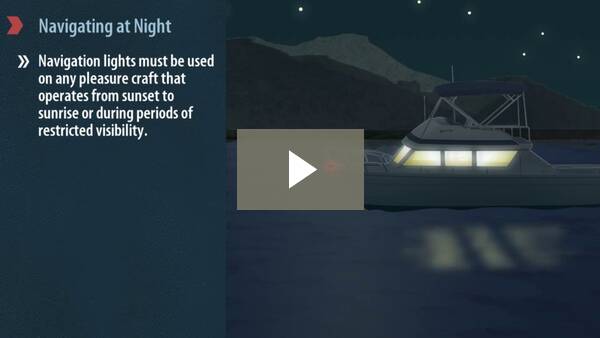Safe Boat Operation and Navigation in Restricted Visibility
Boaters should take additional care to ensure safe boat operation and navigation in restricted visibility, such as fog, darkness or heavy rain.
Remember: If you are operating a pleasure craft and you are not in sight of other vessels due to poor visibility, you are required to proceed at a safe speed that is appropriate for the prevailing circumstances and visibility conditions (as described in the Collision Regulations Rule 19).
Boating at Night
Right-of-way and navigation rules are the same whether operating during the day or at night. However, while operating at night or during periods of restricted visibility you must determine the speed, position, and size of other boats according to the navigation lights they exhibit.
Navigation lights must be used on any pleasure craft that operates from sunset to sunrise or during periods of restricted visibility.
The navigation lights you are required to display depend on the following:
- The size of your craft
- If it is non-powered, sail-driven or power-driven
- If it is underway or at anchor
Navigation Lights
Power-driven pleasure craft must exhibit a forward masthead light, sidelights and a sternlight.
Many small boats (such as bow riders and runabouts) typically have a white light affixed to the top of a light pole that can be placed at the stern of the craft. When underway, this all-round light functions as a combined masthead and sternlight, and must be visible in all directions, mounted higher than the boat structure, cockpit or any other obstruction.
Special Circumstances
Search and Rescue (SAR) Vessels
When responding to emergencies, search and rescue vessels, as well as police and government vessels, exhibit blue light(s). You should steer well clear of a vessel with a blue flashing light.
When Towing
If towing another vessel from your stern, you must show:
- Sidelights and a sternlight
- One yellow towing sternlight
- Two masthead lights in a vertical line
If being towed, you must exhibit:
- Sidelights and a sternlight
- A diamond shape
- If you do not have sidelights you must exhibit two aids to navigation, one each at fore and aft
When a boat that doesn’t normally tow other boats is engaged in towing, it must display the regular navigation lights and indicate the nature of the relationship between the towing boat and the boat being towed (such as illuminating the towline).
Vessels Being Pushed
When using a powerboat to push another vessel ahead or tow alongside, you must exhibit:
- Two masthead lights in a vertical line, sidelights and a sternlight








